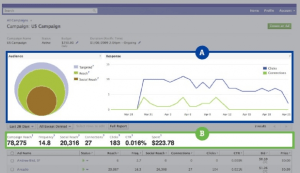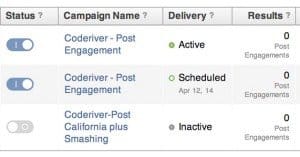 Written by ContentPowered.com
Written by ContentPowered.com
Facebook ads are some of the most potent PPC ads in the world, and it’s all because of the unique combination of factors that led to Facebook’s success. Their massive platform, the huge amounts of personal data people share from day to day, and the ability to use all of that for marketing combines to create the best platform available.
If you know how to use it.
A simple tip to keep in mind is that any time you see someone complaining that Facebook ads had a low conversion rate, or they have excessive costs, or they just don’t work, chances are that person or business had no idea what they were doing and never tried to learn.
The key to success with Facebook ads is two-fold. You need to take the time to learn the platform, the options available to you and the ins and outs of using their PPC system. You also need to test and iterate different improvements until you hit upon one that works.
When you find something that works, abuse it for all its worth. Things change, ads go stale, and what works today might not work tomorrow. Use it until it stop working and find something new to use when you tap the first source out.
What can you learn about the Facebook ads system, and what improvements can you test and iterate to find these pockets of value?
Ad Objective
When you create an ad, you use one of Facebook’s set of objectives. These range from the traditional website clicks to specially tracked website conversions, page post engagement, video views or app installs. Typically, you will be using either page likes, page post engagement, website clicks or website conversions. The other objectives have their place, but don’t use them when they aren’t explicitly what you’re going for.
Remember that in general, the harder an objective is to meet, the more expensive it will be. A page post comment is harder and thus more expensive than a page like. A website conversion is harder and more expensive than a website click. Use the right objective.
Optimize Images
Facebook ads have an image and a text component, and Facebook is strict about not allowing much text in the image portion. This is fine, because a text image is not as compelling or as useful as a straight image.
When in doubt, use action photos, photos of people smiling, or photos of your product. Test variations on every image you use. Sometimes the hair color of the model matters, or the presence of a tinted border, or the orientation of the image. Sometimes the angle of the picture is important.
Try to tailor your picture to the subject at hand and to your audience. Are you selling primarily to new mothers? Pictures of children in various states – clean or dirty, happy or sad, etc – can be very compelling.
You can also go off the wall and use strange, odd or out of place images. You have to be careful, though. You still need some kind of internal logic or consistency to your users don’t click your ad and end up confused.
Optimize Text
There are several places text shows up in your ads. You have your title, you have your URL and you have your copy. You also have the text you can cram into your image, but it’s typically better to leave the image to be an image.
Your title is blue and stands out from the rest of the ad column as something worthy of attention. Make sure it’s something compelling and attention-grabbing. A value proposition is typically a good idea.
Your URL isn’t typically customizable. Facebook just takes the main domain name, not the sub-folders.
Your copy is the biggest source of possible improvements. Experiment with different forms of capitalization, different uses of names, different symbols, and different meanings. Sometimes all it takes is a bit more capitalization to draw in more users. Sometimes an entirely different few words is more beneficial. Play around with it until you strike gold.
Optimize Targeting
Targeting is where the power of Facebook comes in. You can target through a huge number of factors.
- Demographic targeting is the more obvious and is shared amongst most PPC platforms. You can target people based on their age, their location, their gender, their relationship status, their income level, their workplace, their ethnicity, and much more. Typically, demographic targeting is most useful for businesses with certain fixed audiences. A store like Babies ‘R’ Us wouldn’t really want to blindly target teenagers, for example, but new mothers or expecting mothers are good choices.
- Geographic targeting. Worth noting that, while it falls under the general heading of demographic targeting, you have quite of bit of variance with geographic targeting. You can be as broad as excluding entire countries, or as narrow as limiting yourself to just a single city.
- Interest targeting. This is where the most power comes from Facebook ads. Experiment with different interests, typically those interests that best fit with your business.
Lookalike targeting is also incredibly potent. As you build an audience following your Facebook page, Facebook gathers data about those users. You can then create a lookalike audience. Facebook essentially scans their entire database of users for anyone who shares the same interests as the people who follow your page, excluding the people who already follow your page. These people, it stands to reason, are similar to your audience and would be interested in the same things. Use this audience type to get new followers.
Test, Iterate, Test
The key to success with Facebook ads is to test variations. Constantly. If you don’t have at least one test running with two or more variations at all times, you’re probably throwing away money. Sure, when you strike gold, it’s a good idea to go all-in on that ad. That doesn’t mean you should stop running other tested ads, though. You always have room for improvement and you can always take a different angle and find more gold in other areas.




Great writeup James! I’ve already used a few of these tips you’ve mentioned and I plan on trying the ones I haven’t used
Thanks Cletus, glad it helped!